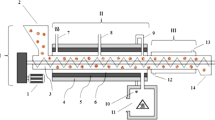Abstract
A bioremediation system for creosote-treated wood is proposed, based on the detoxifying capability of Pleurotus ostreatus, a ligninolythic fungus. Non-sterilized chipped contaminated wood was mixed at various ratios with wheat straw on which Pleurotus mycelia was grown. At 1:2 initial ratio contaminated wood:wheat straw, chemical analyses demonstrated an almost complete degradation of creosote oil components after 44 days, also confirmed by a significant reduction of ecotoxicity. Lower ratios, i.e. higher amount of contaminated wood, lower system efficiency, although a better creosote degradation was obtained by a stepped up wood addition.

Similar content being viewed by others
References
Atagana HI, Haynes RJ, Wallis FM (2006) Fungal bioremediation of creosote- contaminated soil: a laboratory scale bioremediation study using indigenous soil fungi. Water Air Soil Pollut 172:201–219
Becker R, Buge HG, Win T (2002) Determination of pentachlorophenol (PCP) in waste wood method comparison by a collaborative trial. Chemosphere 47:1001–1006
Bezalel L, Hadar H, Fu PP, Freeman JP, Cerniglia CE (1996) Initial oxidation products in the metabolism of pyrene, anthracene, fluorene, and dibenzothiophene by the white rot fungus Pleurotus Ostreatus. Appl Environ Microb 62:2554–2559
CNR-IRSA (1994) Metodi analitici per le acque. 8020. Metodi di valutazione con Daphnia. Quaderno 100:336–342
Dojmi D, Delupis G, Macrì A, Civitareale C, Migliore L (1992) Antibiotics of zoothecnical use: effects of acute high and low dose contamination on Daphnia magna Straus. Aquatic Toxicol 22:53–60
Eggen T, Majcherczyk A (1998) Removal of polycyclic aromatic hydrocarbons (PAH) in contamined soil by white rot fungus Pleurotus Ostreatus. Int Biodeter Biodegr 41:111–117
Galli E, Rapanà P, Tomati U, Polcaro CM, Brancaleoni E, Frattoni M (2006) Degradation of creosote by Pleurotus ostreatus mycelium in creosote-treated wood. Fresen Environ Bull 15:720–723
Lau KL, Tsang YY, Chiu SW (2003) Use of spent mushroom compost to bioremediate PAH-contaminated samples. Chemosphere 52:1539–1546
Majchereczyk A, Hüttermann A (1993) Behandlung mit weißfäulepilzen als weg zur reyklisierung von altholz. In: Hüttermann A, Kharazipour R (eds) Die pflanzliche zellwand als vorbild für holzwerstoffe, vol 113, Sauerländer Verlang, Frankfurt am Main, p 69
Mattei D, Cataudella S, Mancini L, Tancioni L, Migliore L (2006) Tiber River quality in the stretch of a sewage treatment plant: effects of river water or disinfectants to Daphnia and structure of benthic macroinvertebrates community. Wat Air Soil Pollut 177:441–455
Nylund L, Heikkilä P, Hämeilä M, Pyy L, Linnainmaa K, Sorsa M (1992) Genotoxic effects and chemical compositions of four creosotes. Mut Res 265:223–236
Pagnout C, Rast C, Veber AM, Poupin P, Férard JF (2006) Ecotoxicological assessment of PAHs and their dead-end metabolites after degradation by Mycobacterium sp. Strain SNP11. Ecotox Envir Saf 65:151–158
Portier RJ, Hoover DG, Miles MS (1996) Microbial assisted remediation of Creosote- and pentachlorophenol-treated wood products. J Ind Microbiol 17:1–5
Steffen KT, Schubert S, Toumela M, Hataka A, Hofrichter M (2007) Enhancement of bioconversion of high-molecular mass polycyclic aromatic hydrocarbons in contaminated non-sterile soil by litter-decomposing fungi. Biodegradation 18:359–369
Author information
Authors and Affiliations
Corresponding author
Rights and permissions
About this article
Cite this article
Polcaro, C.M., Brancaleoni, E., Donati, E. et al. Fungal Bioremediation of Creosote-Treated Wood: A Laboratory Scale Study on Creosote Components Degradation by Pleurotus ostreatus Mycelium. Bull Environ Contam Toxicol 81, 180–184 (2008). https://doi.org/10.1007/s00128-008-9394-9
Received:
Accepted:
Published:
Issue Date:
DOI: https://doi.org/10.1007/s00128-008-9394-9




